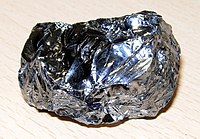
Photo from wikipedia
This paper presents studies on the possibility of utilization of technogenic waste from the metallurgical industry by the method of complex processing in order to reduce the anthropogenic load on… Click to show full abstract
This paper presents studies on the possibility of utilization of technogenic waste from the metallurgical industry by the method of complex processing in order to reduce the anthropogenic load on the environment of the region with the example of the zinc silicate-magnetite-carbon system. The selected sample of clinker dump from welting was subjected to chemical and scanning electron microscopic analyses and thermodynamic modeling. Thermodynamic studies were carried out in the temperature range 1600–2200 K and pressure p = 0.1 MPa, modeling the process of electric melting of clinker from welting in an arc furnace using the software application Astra 4 developed at the Bauman Moscow State Technical University (Moscow, Russian Federation). As a result of the thermodynamic modeling, the optimal temperature range was established, which was 1800–1900 K. Thermodynamic studies established that it is possible to drive away zinc from the system under study by 99–100% in the entire temperature range under study. The maximum degree of silicon extraction (αSi) in the alloy is up to 69.44% at T = 1900 K, and the degree of iron extraction (αFe) in the alloy is up to 99.996%. In particular, it was determined and proved that clinker waste from welting can act as a secondary technogenic raw material when it is processed as a mono mixture to produce iron silicides with a silicon content of 18 to 28%.
Journal Title: Materials
Year Published: 2022
Link to full text (if available)
Share on Social Media: Sign Up to like & get
recommendations!